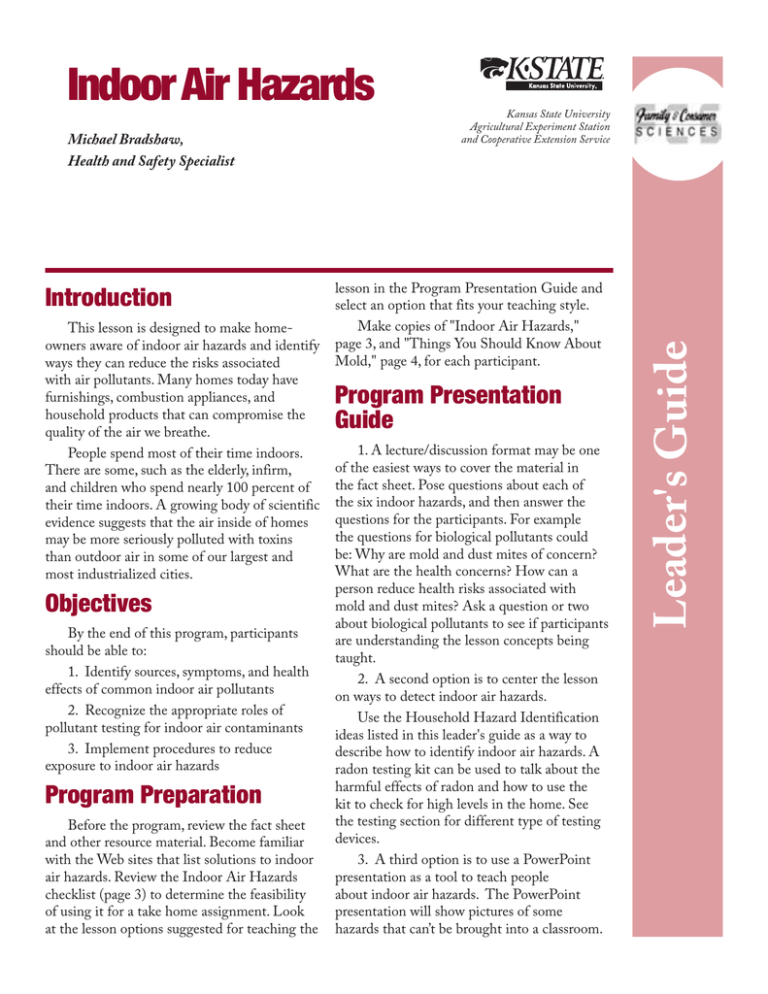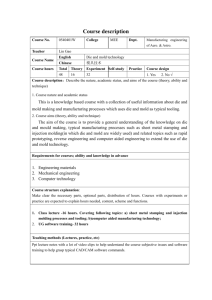
Michael Bradshaw,
Health and Safety Specialist
Introduction
This lesson is designed to make homeowners aware of indoor air hazards and identify
ways they can reduce the risks associated
with air pollutants. Many homes today have
furnishings, combustion appliances, and
household products that can compromise the
quality of the air we breathe.
People spend most of their time indoors.
There are some, such as the elderly, infirm,
and children who spend nearly 100 percent of
their time indoors. A growing body of scientific
evidence suggests that the air inside of homes
may be more seriously polluted with toxins
than outdoor air in some of our largest and
most industrialized cities.
Objectives
By the end of this program, participants
should be able to:
1. Identify sources, symptoms, and health
effects of common indoor air pollutants
2. Recognize the appropriate roles of
pollutant testing for indoor air contaminants
3. Implement procedures to reduce
exposure to indoor air hazards
Program Preparation
Before the program, review the fact sheet
and other resource material. Become familiar
with the Web sites that list solutions to indoor
air hazards. Review the Indoor Air Hazards
checklist (page 3) to determine the feasibility
of using it for a take home assignment. Look
at the lesson options suggested for teaching the
Kansas State University
Agricultural Experiment Station
and Cooperative Extension Service
lesson in the Program Presentation Guide and
select an option that fits your teaching style.
Make copies of "Indoor Air Hazards,"
page 3, and "Things You Should Know About
Mold," page 4, for each participant.
Program Presentation
Guide
1. A lecture/discussion format may be one
of the easiest ways to cover the material in
the fact sheet. Pose questions about each of
the six indoor hazards, and then answer the
questions for the participants. For example
the questions for biological pollutants could
be: Why are mold and dust mites of concern?
What are the health concerns? How can a
person reduce health risks associated with
mold and dust mites? Ask a question or two
about biological pollutants to see if participants
are understanding the lesson concepts being
taught.
2. A second option is to center the lesson
on ways to detect indoor air hazards.
Use the Household Hazard Identification
ideas listed in this leader's guide as a way to
describe how to identify indoor air hazards. A
radon testing kit can be used to talk about the
harmful effects of radon and how to use the
kit to check for high levels in the home. See
the testing section for different type of testing
devices.
3. A third option is to use a PowerPoint
presentation as a tool to teach people
about indoor air hazards. The PowerPoint
presentation will show pictures of some
hazards that can’t be brought into a classroom.
Leader's Guide
Indoor Air Hazards
Mold and dust mites and some chemicals are
best demonstrated through pictures. (Toxic
household chemicals should not be brought
into a classroom or meeting room.)
4. A fourth option for a small group is to
walk participants visually through the Healthy
Home Tabletop Display. Talk about hazards
that could be found in each room of the house.
The Indoor Air Hazard survey can be used
to talk about hazards that can be found in
different rooms of the home.
Homework Assignment
Encourage everyone to take a copy of the
Indoor Air Hazards survey (page 3) and walk
room-by-room through their homes while
checking those items that may be hazardous.
Encourage participants to do something about
any moisture, dust, chemicals or other hazards
that are found.
Household Hazard
Identification
Show some of the items listed below:
Relative humidity (hygrometer – found in
most hardware stores)
Radon test kits (Found in many extension
offices)
CO detectors (Found in hardware and
discount stores)
Empty toxic chemicals containers (under
kitchen sink or garage)
Other resources
Healthy Home Tabletop Display – Can be
checked out of the area K-State Research and
Extension office
Resources
Healthy Indoor Air – http://www.montana.
edu/wwwcxair/train.htm
Indoor Air Hazards – http://www.montana.
edu/wwwcxair/hazards.htm
EPA Hotline resources – http://www.epa.gov/
iaq/iaqxline.html
The Inside Story: A Guide to Indoor Air
Quality – http://www.epa.gov/iaq/pubs/insidest.
html
American Lung Association – http://www.
healthhouse.org/consumer/Tipsheets.asp
Mold EPA – http://www.epa.gov/iaq/molds/
moldresources.html
Mold clean up EPA – http://www.epa.gov/iaq/
molds/
Lead Resources – http://www.epa.gov/lead/
Sick Building Syndrome – http://www.epa.gov/
iaq/pubs/sbs.html#Air%20cleaning
Indoor Air Hazards
Do a room-by-room survey to see if you
have indoor air hazards.
Place a check in the box next to those items
that may need to be changed or modified to
bring your home to a standard that is free of
potential indoor air hazards.
Kitchen
q Excess moisture from cooking and
dishwasher that may encourage the growth
of mold, and mildew, as well as cockroaches
and dust mites.
q Use of unnecessary household cleaners that
give off harmful vapors.
q Unvented gas stove and range that can be
a source of carbon monoxide and gas by
products.
Bathroom and Laundry
q Excess moisture from bathing, clothes
washing that may encourage growth of
mold, and mildew, as well as cockroaches
and dust mites.
q Use of personal care products that can
release organic gases from product
chemicals.
q Unvented clothes dryer that produces
excessive moisture and dust.
q Use of a gas-fired dryer that is not properly
vented.
Living Areas
q Water-damaged carpet that biological
pollutants can grow on or new carpet
exuding organic gases.
q Fireplaces that leak carbon monoxide and
combustion pollutants into the home.
q Moisture encourages the growth of mold,
and mildew, as well as cockroaches and
dust mites.
q Gas or kerosene space heaters that are
located in living quarters and may produce
carbon monoxide and combustion
pollutants.
q Family member or guests that smoke inside
of the home.
q Lead-based paint in home built in 1978, or
earlier, that is peeling, chipping or chalking.
q Animals that leave allergens such as dander,
hair, feathers and skin in the air.
Bedroom
q Humidifier/vaporizer (cold mist type) that
can encourage the growth of mold and
mildew.
q Use of moth repellents that contain
paradichlorobenzene, a pesticide.
Utility, Basement and Hobby Areas
q Ground moisture in basement or other
places in the home that encourages the
growth of mold, and mildew, as well as
cockroaches and dust mites.
q Home has never been tested for radon.
q Home has hobby products such as solvents,
paint, glue, and epoxy that can emit organic
gases.
q Gas or fossil-fuel furnace/boiler and gas
water heaters that are not properly vented
or that may produce backdrafting of carbon
monoxide (CO) and combustion pollutants.
Garage
q Car or small engine exhaust that can
produce sources of carbon monoxide and
combustion by-products.
q Paint, solvents and cleaning supplies that
may release harmful vapors.
q Pesticides, fertilizers and other toxic yard
and garden chemicals.
q Stored fuels such as gasoline and kerosene
that may release harmful vapors.
* Adapted from Healthy Indoor Air for
America’s Homes.
Things You Should Know About Mold
1. There is no practical way to eliminate
all mold and mold spores in the indoor
environment; the way to control indoor
mold growth is to control moisture.
2. If mold is a problem in your home or school,
you must clean up the mold and eliminate
the sources of moisture.
4. Reduce indoor humidity (to 30-60% )
to decrease mold growth by: venting
bathrooms, dryers, and other moisturegenerating sources to the outside; using
air conditioners and de-humidifiers;
increasing ventilation; and using exhaust
fans whenever cooking, dishwashing, and
cleaning.
5. Clean and dry any damp or wet building
materials and furnishings within 24 to 48
hours to prevent mold growth.
6. Prevent condensation: Reduce the potential
for condensation on cold surfaces (i.e.,
windows, piping, exterior walls, roof, or
floors) by adding insulation.
7. If the moldy area is less than about 10 square
feet (less than roughly a 3 ft. by 3 ft. patch),
in most cases, you can handle the job
yourself.
8. Clean mold off hard surfaces with water and
detergent, and dry completely. Absorbent
materials such as ceiling tiles, that are
moldy, may need to be replaced.
9. Avoid breathing in mold or mold spores
when cleaning. In order to limit your
exposure to airborne mold, you may want to
wear an N-95 respirator, available at many
hardware stores and from companies that
advertise on the Internet. (They cost about
$12 to $25.)
10. In areas where there is a perpetual moisture
problem, do not install carpeting (i.e.
bathroom sinks, or on concrete floors with
leaks or frequent condensation).
11. Molds can be found almost anywhere;
they can grow on virtually any substance,
providing moisture is present. There are
molds that can grow on wood, paper, carpet,
and foods.
12. Wear gloves. Long gloves that extend to the
middle of the forearm are recommended.
When working with water and a mild
detergent, ordinary household rubber gloves
may be used. If you are using a disinfectant,
'such as chlorine bleach, or a strong
cleaning solution, you should select gloves
made from natural rubber, neoprene, nitrile,
polyurethane, or PVC. Avoid touching
mold or moldy items with your bare hands.
13. Wear goggles. Goggles that do not have
ventilation holes are recommended. Avoid
getting mold or mold spores in your eyes.
Adapted from EPA
Lesson adapted by Michael Bradshaw, Ph.D.,
Associate Professor and Extension Specialist,
Health and Safety, School of Family Studies
and Human Services.
Reviewed by Carol Fink and Ginny Barnard.
Brand names appearing in this publication are for product identification purposes only.
No endorsement is intended, nor is criticism implied of similar products not mentioned.
Publications from Kansas State University are available on the World Wide Web at: www.oznet.ksu.edu
Publications from Kansas State University may be freely reproduced for educational purposes.
All other rights reserved. In either case, credit Michael Bradshaw, Indoor Air Hazards Leader's Guide,
Kansas State University, October 2007.
Kansas State University Agricultural Experiment Station and Cooperative Extension Service, Manhattan, Kansas
MF2788
October 2007
K-State Research and Extension is an equal opportunity provider and employer. These materials may be available in alternative formats. Issued in furtherance of Cooperative Extension
Work, Acts of May 8 and June 30, 1914, as amended. Kansas State University, County Extension Councils, Extension Districts, and United States Department of Agriculture Cooperating,
Fred A. Cholick, Director.





